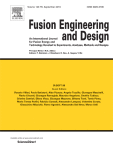|
Authors
Juhera, E. ; Calvet, M.; Revuelta, A.; Abellà, J. ; Calvet, M.; Revuelta, A.; Abellà, J. ; Colominas, S. ; Colominas, S.
|
Abstract
Tritium management is one of the main challenges that future nuclear fusion energy has to achieve. Accurate tritium monitoring is a basic task in order to have relying fusion reactors. High temperature sensors have to be developed to make this monitoring a reality. Hydrogen sensors based on solid-state electrolytes can be a reliable option to perform this monitoring. These types of sensors offer resistance to harsh chemical environments, temperature depending conductivity and quick and easy to measure signals.
Potentiometric and amperometric hydrogen sensors based on solid-state electrolytes were previously studied in our research group. These previous sensors contained a pellet-shaped solid-state electrolyte. Using a one-end closed tube geometry the active area of the sensor increases. This new shape was obtained by a slip casting process. The satisfactory results obtained with both amperometric and potentiometric sensors present a promising path to the development of high temperature tritium sensors that could be used in the breeding blankets of the future nuclear fusion reactors.
In the present work, amperometric sensors performance has been improved by increasing the electrolyte’s active area. Enlarging the electrolyte’s area gives the sensor more sensitivity and reduces its limit of detection and quantification. Analytical parameters of the sensor were compared to other electrochemical hydrogen sensors.
|

WoS
Scopus
Altmetrics
 
|
